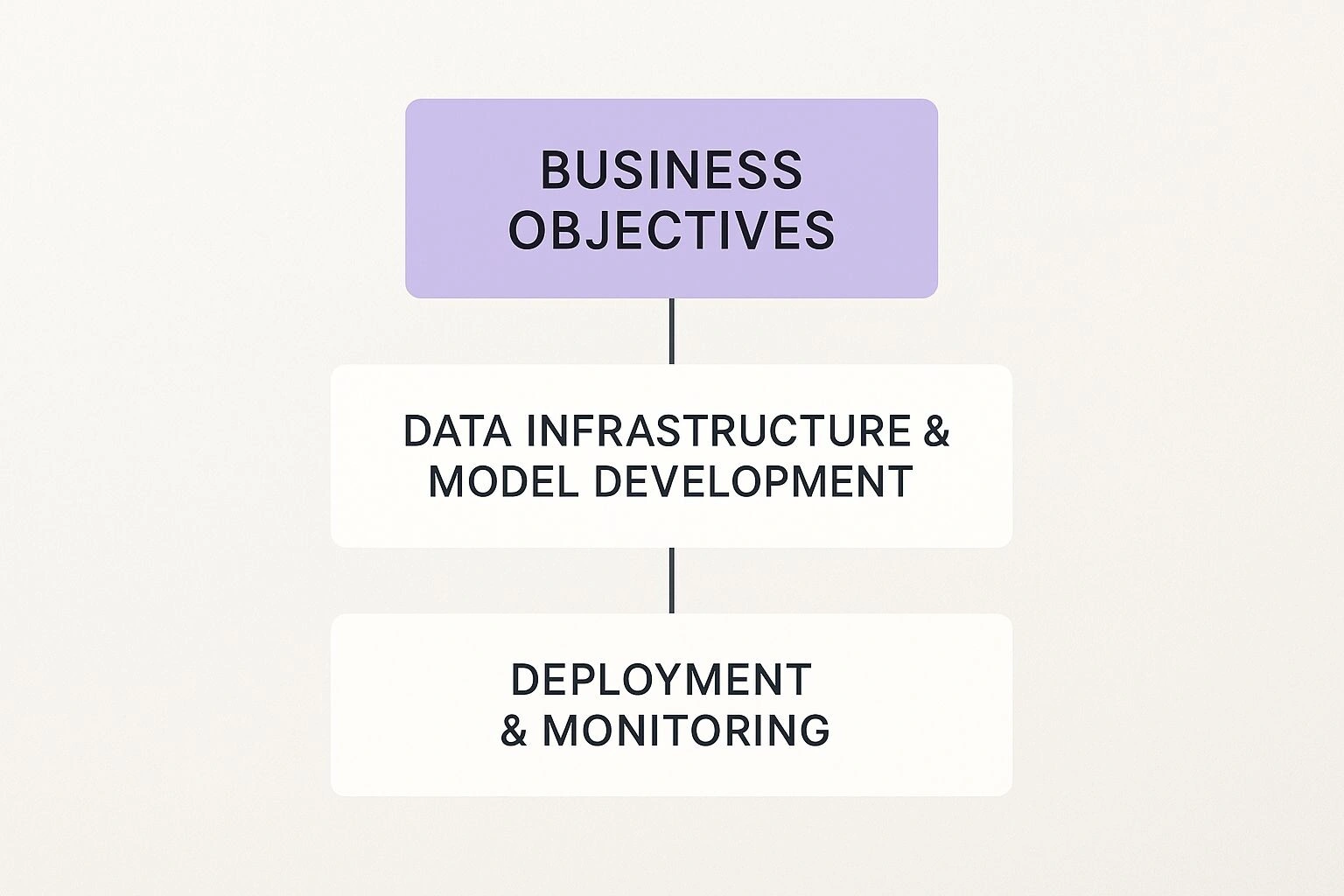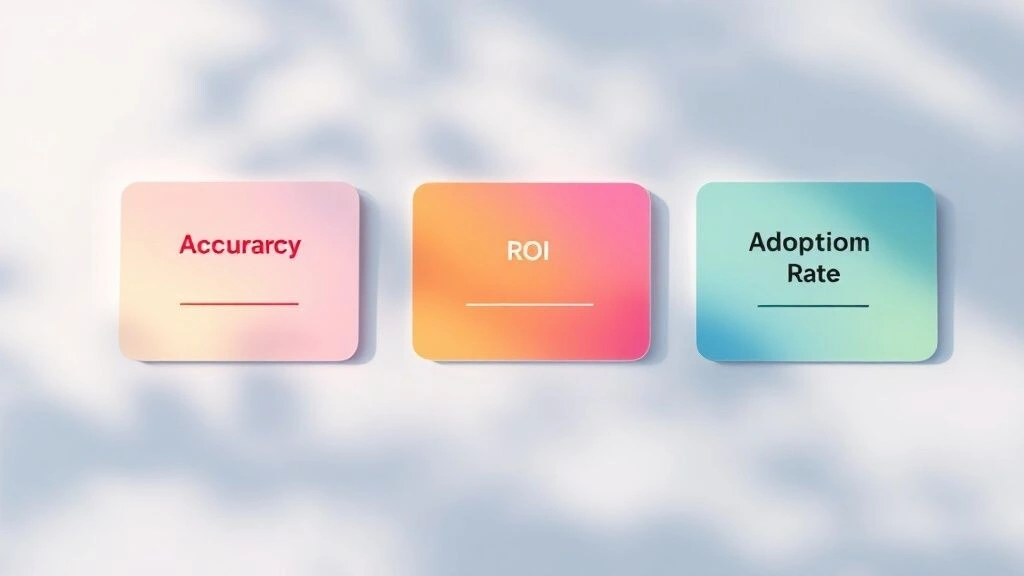A Practical AI Strategy That Actually Works
Tired of the hype? Learn to build a practical AI strategy for your business. This guide offers a clear, step-by-step plan for achieving real results.

The term ‘AI Strategy’ gets thrown around so much it’s almost lost all meaning. It sounds like something only massive companies with huge budgets and fancy innovation labs can touch.
But it’s not that complicated. It really isn’t.
An AI strategy is just your plan for using smart technology to fix real business problems. Simple as that. It’s not about chasing the latest shiny object everyone’s talking about. It’s about looking at your daily grind, your team’s biggest headaches, or your customer’s loudest complaints and just asking… “Could a smart tool help here?”
It’s the bridge between what AI can do and what’s actually useful for your business, helping you decide where to put your time and money to get the best results.
So What Is An AI Strategy Anyway?
Let’s dig a bit deeper into what this actually looks like. Forget the corporate-speak for a minute and let’s think about it in a more down-to-earth way.
Think of It as a Roadmap
Imagine you’re planning a big road trip. You wouldn’t just jump in the car in Sydney and start driving west, hoping you’ll eventually bump into Perth. That would be chaos. You’d burn through fuel, time, and probably your sanity.
You’d get a map. Of course you would. You’d plan your route, figure out where to stop for petrol, and decide what you actually need to pack. An AI strategy is that exact map for your business. It makes you figure out your destination first—the business goal—and then map the best way to get there, so you avoid all those costly detours and tech dead ends.
A solid roadmap helps you:
- Invest wisely: It shows you where to put your precious time and money to actually see a difference.
- Get your team on board: A clear plan helps everyone get the ‘why’ behind what you’re doing. This turns that fear of the unknown into genuine excitement.
- Sidestep distractions: It acts as your filter, stopping you from wasting money on cool-sounding tools that don’t actually help your business.
You’re not just building a strategy for technology; you’re building a strategy for your business’s future. It’s a small shift in thinking, but it’s a powerful one.
It’s a Growing Field Here in Australia
This isn’t just some global trend happening somewhere else. Things are really picking up steam right here at home. Australia’s artificial intelligence scene has seen some pretty amazing growth, and we’re becoming a real player in AI research and development.
In fact, between 2015 and 2024, Australia’s AI-related research nearly doubled its share of our country’s total output. Crazy, right? You can discover more insights about Australia’s AI ecosystem growth and opportunities from the CSIRO if you’re into that sort of thing.
What does this mean for you? It means there’s more local expertise, more relevant tools, and a bigger community to learn from. It’s the perfect time to start thinking seriously about your own plan.
We’re going to demystify this whole thing together. No hype, just a practical look at how you can create a simple, effective AI strategy that actually works for your business. It all starts with understanding why you can’t just dive in headfirst.
Why You Need a Plan Before Diving into AI
I get it. That feeling is almost electric. A new AI tool drops, and the urge to just jump in and start playing is overwhelming. It even feels productive, doesn’t it?

But diving in without a plan is a bit like trying to assemble flat-pack furniture without the instructions. You might get something that looks a bit like a bookshelf… or you might end up with a wobbly mess, a pile of leftover screws, and a whole lot of frustration. I’ve been there. It’s not pretty.
An AI strategy is your instruction manual. It’s the one thing that stops you from burning cash and time on shiny tech that isn’t right for your business.
Avoiding the “Cool Tech” Trap
Without a plan, it’s so easy to get distracted by what’s popular instead of what’s practical. This is the single biggest mistake I see businesses make. They start with the technology and then try to find a problem for it to solve. That’s completely backwards.
A proper AI strategy forces you to start with the real-world business problem. It makes you ask the hard questions first.
- What’s the biggest bottleneck in our sales process right now?
- Where are my staff spending hours on tedious, mind-numbing work?
- What’s the most common complaint we get from our customers?
Answering these questions gives you a target. Then, and only then, do you start looking for the right tool to hit it. This simple shift in focus is the difference between making a cool tech demo and actually creating business value.
A great AI strategy doesn’t start with a question like, “How can we use generative AI?” It starts with, “How can we reduce customer wait times by 30%?” The technology is the answer, not the starting point.
The Real-World Risks of Skipping the Plan
This isn’t just about wasting a bit of money on a software subscription you don’t use. Going in without a clear plan opens you up to some serious risks that can cause a world of pain down the track. It’s not about creating red tape for the sake of it… it’s about being smart and protecting your business.
For example, without a strategy, you might accidentally feed sensitive company or customer data into a public AI model. That’s a security and privacy nightmare waiting to happen. You could also roll out an automated system that annoys your customers because it feels clunky or impersonal, damaging the trust you’ve worked so hard to build.
Giving Your Team a Clear Direction
Perhaps one of the most overlooked parts of this is your team. When you just throw new tools at them without context or a clear goal, it creates confusion and anxiety. People start pulling in different directions, messing with random tools, and nobody even knows what success is supposed to look like.
A clear AI strategy gives everyone a shared direction. It’s the compass that makes sure every department is heading towards the same destination. It changes the conversation from “What does this new tool do?” to “How can we use this tool to achieve our shared goal?”
Honestly, a little bit of thinking upfront saves you so many headaches later. It turns AI from a potential distraction into a powerful, focused asset for your business. It’s the difference between hoping for a good outcome and actually engineering one.
The Core Components of a Strong AI Strategy
Alright, we agree a plan is essential. But what actually goes into a solid AI strategy? It’s less about complex charts and more about honestly answering a few key questions.
Think of it like building a house. You wouldn’t just start laying bricks without a blueprint, would you? You need to know what you’re building, what materials you have, and who’s going to do the work. It’s the same with AI. You need a clear plan built on a solid foundation.
Let’s break down the essential pillars of that foundation.
Start with Your Business Goals
First things first. What’s your ‘why’? What problem are you actually trying to solve? This is the most crucial part, and surprisingly, it’s the one most businesses rush past.
Are you trying to claw back hours from mind-numbing admin? Maybe you want to delight your customers with faster, more personalised responses. Or perhaps it’s about fuelling growth by uncovering better leads.
Vague wishes won’t cut it. “Improve efficiency” is a nice thought, but “Cut invoice processing time by 50%” is a tangible goal you can build a strategy around. You can feel that.
This visual shows how your objectives are the bedrock for everything else.

As you can see, clear business goals dictate the kind of data you’ll need and the technology you’ll choose to get there.
Get a Handle on Your Data
Next up is the fuel for any AI engine: your data. You can have the most powerful car on the planet, but without petrol, it’s just a very expensive lawn ornament. AI is no different.
You need a clear picture of what data you have, where it lives, and whether it’s in any shape to be useful. It’s often scattered everywhere. In spreadsheets. Buried in your CRM. Locked away in old accounting software. A total mess, usually.
The success of your AI depends entirely on the quality and accessibility of your data. Rubbish in, rubbish out… it’s as simple as that.
This means getting serious about how you manage your data is non-negotiable. Thinking about this now will save you a world of pain later. For a deeper dive, our guide on what data governance is and why it matters is a great place to start.
Don’t Forget the People
This part is huge. You can have the perfect plan and the cleanest data, but if your team isn’t on board, your strategy is dead in the water. Who in your team is actually going to use these new tools?
What skills will they need? More importantly, how do you get them excited about this change instead of feeling threatened by it? That fear is real for a lot of people, and you can’t just ignore it. A core part of your AI strategy must be about clear communication, proper training, and showing people how these tools make their jobs better, not redundant.
Choose Your Technology and Ethics Wisely
Finally, we get to the tech. Notice this is the last piece of the puzzle, not the first. Only once you know your goals, your data situation, and your people plan should you start looking at tools. To implement a robust AI strategy, understanding the available technology is key; you might consider exploring the 12 best AI tools for small business leverage.
Hand-in-hand with technology comes responsibility. You need to set clear guidelines for using AI ethically. How will you protect customer privacy? How will you make sure the AI’s decisions are fair and unbiased? Thinking about this upfront isn’t just good ethics; it’s good business that protects your reputation. The potential here is massive, with AI expected to drive approximately AUD 115 billion in annual gains for Australia by 2030.
A Simple Framework to Build Your First Strategy
Right, enough with the theory. Let’s get practical and actually build something. I’m going to walk you through a simple, three-step process for creating your first AI strategy from scratch.
No confusing jargon, I promise. This is a framework you can put to work today.

It’s all about starting small, proving the value, and then building momentum from there. You don’t need a massive budget or a team of data scientists to get moving. You just need a bit of focus.
Step 1: Start with a Problem Hunt
Before you even think about technology, you need to go on a problem hunt. This is the most crucial step, and it has nothing to do with code or algorithms. It’s about listening.
Your mission is to find the biggest, most annoying, time-sucking pain points in your business.
So, where do you start looking?
- Talk to your team: Ask your customer service people what question they answer a hundred times a day. Ask your sales team what tedious admin task stops them from actually selling. You’ll be amazed at what you find. I guarantee it.
- Listen to your customers: What are the most common complaints you hear? Is your quoting process too slow? Is it hard to get a simple status update? Your customer frustrations are goldmines for AI opportunities.
The goal here isn’t to find a problem that fits AI. It’s to find a real, painful business problem that AI might just be the perfect solution for.
Step 2: Pick a Manageable Pilot Project
Once you’ve got a few good candidates, it’s time to choose your first pilot project. And the key word here is pilot.
Don’t try to change your entire business at once. That’s a recipe for disaster. Instead, pick one small, manageable project where you can test the waters and get a quick win. This is all about building confidence… for you and for your team.
A good pilot project should have a few key ingredients:
- A Clear Goal: It has to be measurable. “Improve our inbox” isn’t a goal. “Reduce email response time for new enquiries by 40%” is a goal.
- Available Data: You need the raw materials to work with. For instance, if you want to automate email responses, you need a good history of past emails. Understanding how to work with your own information is essential, and it’s worth reading up on how to train AI on your own data to get a better handle on this.
- A Visible Impact: Choose something that, if it works, people will notice. A small, visible win creates incredible momentum for what comes next.
Think of your first project like dipping a toe in the water, not a massive cannonball. You’re testing the temperature and getting a feel for things before you jump all the way in.
Once you’ve run your pilot, be honest. Did it work? Did you hit your measurable goal? If yes, fantastic. If not, that’s okay too. You’ve just learned something valuable without betting the entire farm.
Step 3: Learn and Scale Your Success
So, you’ve got your first small win. Brilliant. The temptation now is to just move on to the next shiny object. Resist it.
The final step is to pause and learn. What went well? What was surprisingly difficult? What did you discover about your data, your team’s skills, or the technology itself?
Document these lessons. They are the true foundation of your long-term AI strategy.
Now, you can start to scale. Take the insights from your successful pilot and look for similar problems elsewhere in the business. If you successfully automated responses for your sales inbox, could the same approach work for your support team?
This isn’t about running a single, one-off project. It’s about creating a continuous cycle of improvement:
- Hunt for a problem.
- Pilot a small solution.
- Learn from the result.
- Scale what works.
By repeating this simple loop, you gradually build your AI capability, your team’s confidence, and a growing list of tangible business results. That, right there, is how a real, working AI strategy is born. Not in a boardroom with a 100-page document, but with a single, successful pilot project.
How to Bring Your Team on the AI Journey
Here’s a truth that often gets lost in all the tech hype: your brilliant AI strategy is worthless if your team is scared of it. Or worse, if they actively hate it.
Let’s be honest for a moment. That fear is real, and it’s not irrational. A huge chunk of the anxiety swirling around AI comes from one simple, very human place… the fear of being replaced.
So, a massive part of your strategy can’t just be about data models and pilot projects. It has to be about your people. It’s about clear communication, practical training, and fundamentally changing the story from “a robot is coming for your job” to “here’s a co-pilot to make your job better.”
Change the Conversation From Fear to Curiosity
The way you talk about AI inside your business matters more than you might think. If you lead with dense technical jargon and lofty, intimidating goals, you’ll see the walls go up almost immediately. People will nod along in meetings but secretly be updating their resumes.
You have to make this feel less like a top-down order and more like a shared expedition into new territory.
Start by focusing on the “what’s in it for them.”
- Frame AI as a tool to eliminate the boring stuff. Think: “What if you never had to manually copy and paste data from one spreadsheet to another again?”
- Talk about it as a way to amplify their skills, not make them obsolete. For example: “Imagine having an assistant that could research and summarise industry reports in minutes, freeing you up to focus on actual strategic thinking.”
- Be brutally honest about the coming changes. Acknowledge the uncertainty, but anchor it in a compelling vision of a more interesting, less tedious future for everyone.
Dealing with this kind of resistance is a non-negotiable skill for any leader today. We’ve actually put together some practical advice on overcoming employee resistance to automation that you might find helpful.
Training That Actually Builds Confidence
Throwing a few software tutorials at your team and calling it ‘training’ just won’t cut it. Real, effective training isn’t about teaching people which buttons to click. It’s about building genuine confidence and sparking curiosity.
This means getting practical with role-specific workshops. Show your sales team how an AI tool can help them draft more effective follow-up emails. Let your marketing team play with generative AI to brainstorm fresh campaign ideas.
The goal of training shouldn’t just be ‘competence’. It should be ‘confidence’. When people feel confident enough to experiment without the fear of breaking something, that’s when the real magic starts to happen.
This hands-on approach is becoming more critical than ever. Between 2020 and 2021, the demand for AI skills in the Australian job market nearly doubled. That demand is still climbing, especially in sectors like Financial Services, which saw an 11.8% increase in AI-skilled job postings in 2024. You can read the full research on the growth of AI jobs to see just how quickly the landscape is shifting.
Find Your AI Champions
In every organisation, there are a few people who are naturally curious. They’re the ones already playing with new tools in their spare time. You need to find these people.
These are your AI Champions.
They aren’t necessarily your most senior people or even the most technical. They’re the enthusiasts. Your job is to empower them. Give them the space and tools to experiment, then let them share what they’re learning with their colleagues in an informal, low-pressure way.
A recommendation from a trusted colleague is a thousand times more powerful than a formal email from management. These champions become your internal translators, showing everyone else, in a relatable way, that this new technology is something to be excited about, not feared. When your team truly embraces these tools, that’s when you’ll start to see genuine breakthroughs.
Common AI Strategy Questions Answered

Still got a few questions buzzing around? That’s completely normal.
This is new territory for most of us, so feeling a little uncertain is totally okay. In fact, it’s a good sign. It means you’re taking this seriously and thinking it through properly.
Let’s tackle some of the most common things people ask when they start mapping out their AI strategy.
How Much Does It Cost to Implement an AI Strategy?
Honestly, this is a classic ‘how long is a piece of string?’ question. The cost can range from almost nothing right up to millions of dollars.
But here’s the thing: you shouldn’t be starting with a big budget in mind anyway. That’s coming at it from the wrong direction.
Your first steps can, and probably should, involve free or low-cost tools already on the market. Think about using ChatGPT to brainstorm marketing angles or trying an AI meeting assistant to see if it genuinely saves your team time. These early experiments cost next to nothing.
The strategy itself—the actual plan—costs nothing but your time and focus to create.
The goal isn’t to secure a massive budget. The goal is to prove the value with small, low-risk pilot projects first. Once you have a clear, measurable win, you can use that success to confidently justify a larger investment down the track.
Don’t ever let budget fears stop you from simply getting started.
Do I Need to Hire a Data Scientist Right Away?
Nope. Absolutely not. This is a huge misconception that holds so many businesses back.
To build your initial AI strategy, you don’t need a technical genius. You need someone who understands your business inside and out. Its goals, its customers, and its biggest problems. And that person is probably you or someone already on your leadership team.
Bringing in highly specialised technical experts only makes sense when you have a specific, well-defined problem that genuinely requires their deep skills. It’s like calling a plumber… you don’t keep one on retainer just in case, you call them when a specific pipe has burst.
Many of today’s most useful AI tools are designed for non-technical people. Focus on the ‘what’ and the ‘why’ first. You can always find the ‘who’ to handle the technical bits later on, if and when you actually need them.
How Do I Measure If My AI Strategy Is Working?
This is probably the most critical question of all. Getting this right is the difference between success and just expensive guesswork.
Success is never, ever “we are now using AI”. That’s an activity, not an outcome. Real success is what that AI helps your business achieve.
Before you kick off any pilot project, you absolutely must define what success looks like in concrete, measurable numbers. If you skip this part, you’re flying blind.
Here are a few examples of what real success metrics look like:
- Reducing the average customer service response time by 20%.
- Increasing qualified leads from our website by 15%.
- Saving each team member five hours a week on tedious administrative tasks.
Your metrics have to be tied to real business outcomes you can actually track. If you can’t measure the impact, you’ll never know if your AI strategy is delivering results or just creating noise. It keeps everyone honest and focused on what truly matters.
What Is the Biggest Mistake Businesses Make with AI?
This one’s easy. By far, the most common and costly mistake is starting with the technology instead of the business problem. I see it happen all the time.
People get excited by a flashy new AI tool they’ve seen online. It looks amazing, it promises the world, and they immediately start scrambling to find a use for it inside their business.
That is completely backwards. It’s a recipe for wasted time, money, and a whole lot of frustration.
A successful AI strategy always begins with a genuine business problem. You identify the headache first, and only then do you go looking for the right tool to act as the aspirin.
Start with the pain, not the platform. It’s the simplest rule, but following it will save you from countless dead ends on this journey. It ensures you’re not just adopting technology for its own sake, but using it as a sharp, focused tool to make your business stronger.
Ready to move from questions to action? At Osher Digital, we specialise in creating practical AI and automation solutions that solve real business problems. We can help you build a strategy that delivers measurable results. Find out how we can help your business by visiting us at [[https://osher.com.au](https://osher.com.au]https://osher.com.au](https://osher.com.au).
Jump to a section
Ready to streamline your operations?
Get in touch for a free consultation to see how we can streamline your operations and increase your productivity.